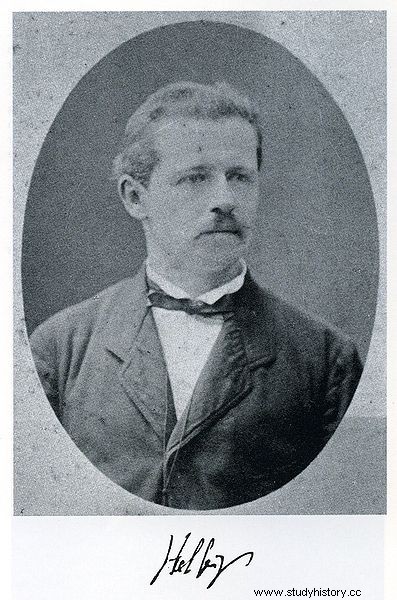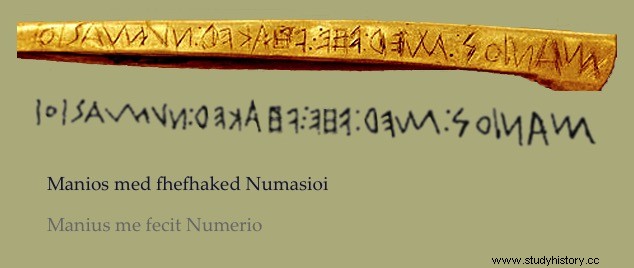In 1887 the archaeologist Wolfgang Helbig presented to the astonished members of the German Institute in Rome a small piece of gold, a fibula barely 10 and a half centimeters long, used to fasten clothing such as togas.
According to him, it had been found in 1871 in the ancient Latin city of Palestrina, which archaeological excavations dated to the 6th century BC. However, he did not explain that he had not actually been the author of the discovery. On the contrary, he had acquired the piece from Francesco Martinetti, an antiquities dealer and known forger, of a doubtful reputation.
When that information became public, suspicions of fraud began to grow. Not because of the piece itself, in fact similar fibulae had been found on other occasions, but because Helbig's contained an inscription, and if authentic it would be the oldest Latin inscription found up to then (a condition that it still retains today).

That inscription, which is in archaic Latin from the Etruscan era, would date to the 7th century BC. and says:Manios med fhefhaked Numaiosi (Manius made me for Numerius ).
Supposedly the fibula appeared in what is known as the Bernardini tomb, which was excavated in 1876 and not in 1871 as Helbig initially claimed. Suspiciously, he was also unable to indicate where in the tomb it had been found or who had done it. Georg Karo, a contemporary archaeologist of Helbig, assured that Helbig had confessed to him that the fibula was stolen from the tomb, although he did not specify more.
However, Helbig's reputation was finally enough to overcome doubts and, for a century, the authenticity of the piece was taken for granted.
But in 1980 epigrapher Margherita Guarducci published a book in which she espoused the theory that, even if the fibula might be authentic, the inscription would be a forgery by Francesco Martinetti. Moreover, he would have agreed with Helbig to perpetrate the deception at the end of the 19th century and thus relaunch the careers of both.
Since then the controversy has not abandoned the piece. In 1999 Massimo Poetto and Giulio Faccheti found an Etruscan inscription from the orientalizing period (end of the 8th century BC – 7th century BC) in an aríbalo (a type of ceramic vessel) in which the name Numasiana appears. . This would confirm the authenticity of the name Numaiosi that appears on the fibula.

And in 2011 a team of researchers led by Edilberto Formigli (university professor of Sciences Applied to Cultural Assets) and Daniela Ferro (chemist at the Italian Institute for the Study of Nanostructured Materials) carried out new analyses, using the latest technologies.
Electron microscopes and X-ray microprobes were used, which combined with the methods of physical chemistry and knowledge of Etruscan goldsmithing techniques, led them to conclude that both the fibula and its inscription are undoubtedly authentic and much older. than the 120 years attributed to them by supporters of the counterfeit theory.
The definitive proof was the detailed physical and chemical analysis of the surface between the indentations of the inscription, which revealed the existence of gold microcrystals, a natural phenomenon that could only have occurred in the course of the centuries after the smelting of the fibula, impossible to replicate by a 19th century forger.
The Prenestine Fibula, today the oldest Latin inscription known, is kept in the Pigorini Prehistoric Ethnographic Museum, in Guglielmo Marconi square in Rome, and can be visited from Tuesday to Sunday from 8 a.m. to 4 p.m. 7 pm.
